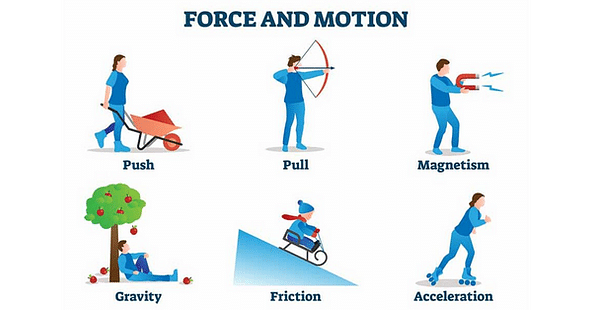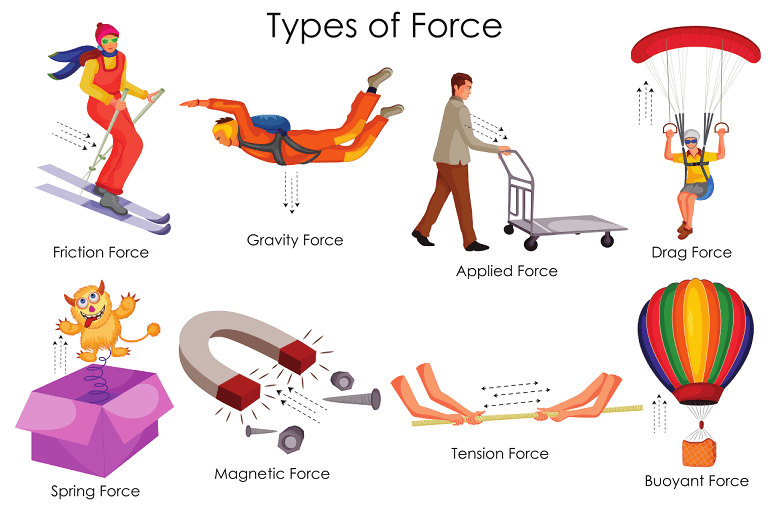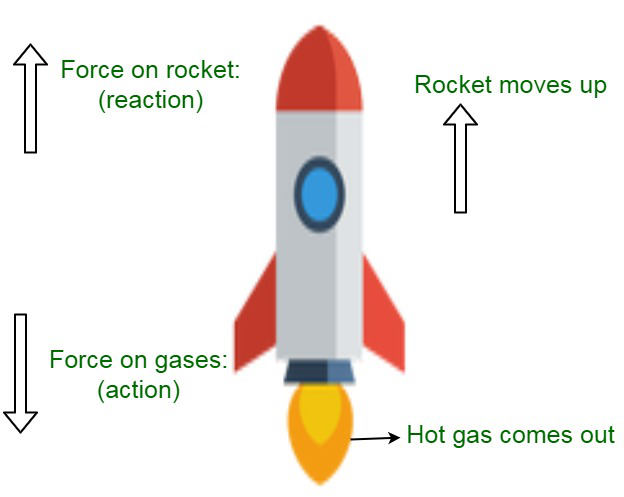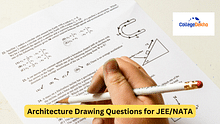Newton’s laws of motion represent an important and scoring chapter for the students in Physics. Check on this page all the concepts related to Newton’s laws of motion and other important formulas.

Newton's First Law of Motion
Newton’s first law of motion states that “an object at rest stays at rest and an object in motion stays in motion with the same speed and direction unless acted upon by an unbalanced force.”
Inertia & Mass
If we simplify Newton’s first law of motion, it says that whatever an object is doing, it will keep doing the same. It is very difficult for objects to resist their state of motion. This resistance of an object to its state of motion is termed as Inertia.
Galileo’s Concept of Inertia
Galileo was one of the most prominent scientists in the 17th century who coined the term Inertia. As per his explanation, the objects that are moving will come to a stop by a force known as friction. In order to prove this, Galileo carried out an experience where two inclined plains faced each other. When he rolled down a ball from one plain, it would go up the opposite plane with the same height. He also explained that the difference between starting and stopping height is due to friction. He further stipulated that in absence of friction, both the balls will reach equal heights.
Mass
It is common for all objects to resist their state of motion with their tendency of Inertia. However, it is also possible that some of the objects have more Inertia tendencies than others. This tendency of an object to resist change in its motion is varied as per the mass of the object. The mass of an object is the quantity that is completely dependent on the inertia of that object. The inertia and mass are directly proportional to each other. Massier the object, the more its tendency to resist change.

State of Motion
The state of motion of an object is explained using its velocity which is the speed of an object with respect to a direction. Based on the state of motion, inertia can be segregated into two definitions: Velocity & Acceleration.

Interia in Terms of Velocity
If an object is at rest, it will have zero velocity and if there is no unbalanced force, it will stay at zero velocity. Until and unless acted upon by an unbalanced force, the object will not change its state of rest. Hence, we can say that objects resist the change in their velocity.
Interia in Terms of Acceleration
If an object is not changing its velocity, its acceleration will be 0 meters per second. Hence, we can say that objects resist the change in their acceleration. Hence, an object in motion will stay in motion and vice versa.
Also Read:
Balanced & Unbalanced Forces
Balanced Forces
To understand the balanced and unbalanced force concept, let us take an example. Lets suppose a book is placed on the top of a table. Now, there will be two different forces acting on that book. One will be the gravitational pull of Earth which will be implying a downward force and the second will be the normal force of the book on the table which will push the book in the upward direction. Now, these two forces are in opposite directions but of equal magnitude. Hence, they will balance each other and this state of the book will be known as equilibrium. Since there is no unbalanced force on the book, it will maintain the state of its motion. The same happens when we stand on a plane floor.

Unbalanced Forces
Now let us go back to the same book on the table and slide it from left to right. Now the book will be in motion where it is only pushed to the left and not right. So even though the upward and downward forces in the book are balanced, there is no balanced force for friction. Due to the unbalanced force of friction, the book will change its motion. The book accelerated due to unbalanced force.
Also Check CBSE Class 12 Exam Pattern 2023
Force and Its Representation
A force is known as a pull or push on an object which results from the contact of an object with another object. Whenever one object contacts another object, they exert force on each other. However, Forces only exist as a result of an interaction.
Categories of Forces
The force of one object on another can be classified into two categories:
- contact forces and
- forces resulting from action-at-a-distance
Contact forces are such forces when two objects are in physical contact with each other. Examples of contact forces are tensional forces, frictional forces, air resistance forces, applied forces, and normal forces.
Action at a distance forces is such forces that occur even when two objects are not in physical contact with each other. Such objects are still able to exert a push or pull force on each other. An example of Action at a distance force is gravitational pull.
Newton
Force is a quantity that is measured using the standard metric unit known as Newton. Newton is abbreviated as N. For 9.0 N, there will be 9.0 Newton of force. One Newton is the amount of force required to give a 1-kg mass an acceleration of 1 m/s/s. Thus, the following unit equivalency can be stated:
1 Newton = 1 kg • m/s2
Types of Forces

As we discussed, all the types of forces are categorized under two categories. The table below discusses all the types of forces with explanation:
Type of Forces | Symbol | Explanation |
|---|---|---|
Applied Force | Fapp | Applied force is the type of force that is applied by a person to an object. For example, a person pushing a table from one side to another. |
Gravity Force | Fgrav | Gravity force is the type of force through which the sun, earth, or other massive objects attract another object towards itself. It is also known as the weight of the object. The force of gravity on earth is always equal to the weight of the object as found by the equation: Fgrav = m * g where g = 9.8 N/kg (on Earth) and m = mass (in kg) |
Normal Force | Fnorm | Normal force is the type of force which is exerted by an object to another object that is in physical contact with each other. For example, if a person leans against a wall, the wall pushes horizontally on the person. |
Friction Force | Ffrict | Friction force is the type of force that is exerted by a surface when an object tries to move towards it. These are of two types: static and sliding friction. Friction results from the two surfaces being pressed together closely, causing intermolecular attractive forces between molecules of different surfaces. The maximum amount of friction force that a surface can exert upon an object can be calculated using the formula below: Ffrict = µ • Fnorm |
Air Resistance Force | Fair | The air resistance is a type of frictional force that exert force on an object when they travel through the air. This is often in the direction of the opposite of the motion of an object. |
Tension Force | Ftens | The tension force is the type of force that is transferred through a wire or string when it is pulled tight by the opposite forces. The tension force is directed along the length of the wire and pulls equally on the objects on the opposite ends of the wire. |
Spring Force | Fspring | The spring force is the type of force that is exerted by a stretched or compressed spring on its attached object. An object that compresses or stretches a spring is always acted upon by a force that restores the object to its rest or equilibrium position. |
Drawing Free Body Diagrams
Free body diagrams are diagrammatic representations of the direction of all forces and the relative magnitude of an object. Such diagrams are also an example of vector diagrams. The only rule for drawing free-body diagrams is to depict all the forces that exist for that object in the given situation. Some other rules for drawing free body diagrams are listed below:
- The arrow size in a free body diagram represents the magnitude of the force.
- The direction of the arrow represents the direction of the force in which it is acting.
- The force arrows in the diagram are labeled to represent the exact force type.
- The object is represented in the diagram using a box.
Given below is an example of a free body diagram:
Newton's Second Law of Motion
Newton’s second law of motion states that “the acceleration of an object is dependent upon two variables - the net force acting upon the object and the mass of the object.” It is mainly related to the behavior of objects for which all existing forces are not balanced.

Definition
The acceleration of an object as produced by a net force is directly proportional to the magnitude of the net force, in the same direction as the net force, and inversely proportional to the mass of the object.
Equation
Newton's Second Law of Motion can be represented using the following equation:
a = Fnet / m
OR
Fnet = m • a
OR
1 Newton = 1 kg • m/s2
Acceleration
The acceleration can be found out using three net force, gravitational force, and frictional force. It can be determined by understanding that the acceleration of an object requires knowing the net force and the mass. If mass (m) and net force (Fnet) are known, then the acceleration is determined by the use of the equation.
a = Fnet / m
Individual Forces
The individual forces can be found using three net force, gravitational force, and frictional force. It can be determined by understanding that the individual force of an object requires the application of Newton's second law (Fnet=m•a) and an application of the meaning of the net force. If mass (m) and acceleration (a) are known, then the net force (Fnet) can be determined by use of the equation.
Fnet = m • a
Free Fall and Air Resistance
Why do all the objects free fall at the same rate of acceleration irrespective of their mass? In order to understand this, the second law of motion can be applied. This will analyze the motion of an object which is free falling and falling under air resistance & gravity.
Free Fall Motion

Free fall is a motion type in which the only force acting on an object is gravity. This means in free fall, there is no air resistance on the object and they fall directly under the influence of gravity. In this situation, all the objects will fall with the same rate of acceleration irrespective of their mass. To understand this, let us take an example of 1000 kg Elephant and 1 kg cotton.
If we apply the second law of motion to these objects’ falling and create a free-body diagram, we will see that the elephant encounters a greater force of gravity than the cotton. This will have a direct impact on the acceleration of the elephant. Now, acceleration depends on two factors: mass and force. Since the elephant has much more mass than the cotton, each object will accelerate at the same rate. Hence, the ratio of force to mass (Fnet/m) is the same for the elephant and the mouse under situations involving free fall.
Falling with Air Resistance
Whenever an object falls through the air, it will encounter some air resistance. Air resistance occurs when the leading surface of the object collides with the air molecules. The air resistance faced by the object will also depend on various other factors. In simple words, the most common factors which impact air resistance are the cross-section area and the speed of the object. More the speed, the greater the air resistance. The more the cross-sectional area more the air resistance.
When an object starts falling, it increases its speed. This lead to an increase in air resistance. Eventually, the air resistance force becomes large enough to balance the gravitational force. In this situation, the net force is 0 N, hence, the object will stop accelerating. This object will be said to have reached a terminal velocity. The change in velocity terminates as a result of the balance of forces. The velocity at which this happens is called the terminal velocity.
Newton's Third Law of Motion
As per Newton's laws of motion, whenever two objects interact with each other, they exert force on each other. These two forces of two objects are called action and reaction forces and are the subject of Newton's third law of motion. Newton’s Third law of motion states that “For every action, there is an equal and opposite reaction.”
This means that for every interaction between two objects, there will be two forces acting. The size of the forces on the first object equals the size of the force on the second object. The direction of the force on the first object is opposite to the direction of the force on the second object. Forces always come in pairs - equal and opposite action-reaction force pairs.
Interaction Force Pairs

As per the third law of motion, forces always come in pairs which are also termed as "action-reaction force pairs." The force pairs can be identified by understanding who is pushing whom and in which direction. Let's take an example of baseball and bat. The baseball will push the bat to the left and the bat will push the ball to the right. Together, these two forces exerted upon two different objects form the action-reaction force pair.
Sample & Previous Year's Questions
- A 2-kg object is moving horizontally with a speed of 4 m/s. How much net force is required to keep the object moving at this speed and in this direction?
- A 4.0-kg object is moving across a friction-free surface with a constant velocity of 2 m/s. Which one of the following horizontal forces is necessary to maintain this state of motion?
Previous Years Questions Links
The students can also refer to the following previous year's questions to learn more about the type of questions asked in the exam:
Stay tuned to CollegeDekho for more Education News! You can also join our Telegram Group for the latest Education news & updates!


















Similar Articles
UP B.Ed JEE 2024 Hindi/ English: List of Important Topics & Weightage
Jharkhand B.Ed Entrance Exam 2024: Admit Card, Exam Date (April 21), Answer Key, Result
Jharkhand B.Ed Entrance Exam 2024 Section-Wise Preparation Tips
Jharkhand B.Ed Entrance Exam 2024 Syllabus and Section-Wise Weightage
How to Prepare for Jharkhand B.Ed Entrance Exam 2024?
NEP 2020: 3-Year vs 4-Year Bachelor’s Degree, 1-Year Master’s Course, Exit Option, Multidisciplinary Education